Guide for French Helmets 1914-1945
Article about: Hi there, I decided since many people that I've come across the years that I've been collecting have struggled with French helmets (and by no means am I an expert due to the limited amount o
-
 Guide for French Helmets 1914-1945
Guide for French Helmets 1914-1945
Hi there,
I decided since many people that I've come across the years that I've been collecting have struggled with French helmets (and by no means am I an expert due to the limited amount of time I've been collecting and recourses available, but I never stop researching and thought my knowledge may be useful to some). So I have a few examples of helmets that should be able to help people identify French helmets easier and overall help those to learn more about French helmets though the wars and common and uncommon things people may run across and how to identify them (I'm only posting helmets that I have in my collection so some models of French helmets will not be shown but the most common ones will).

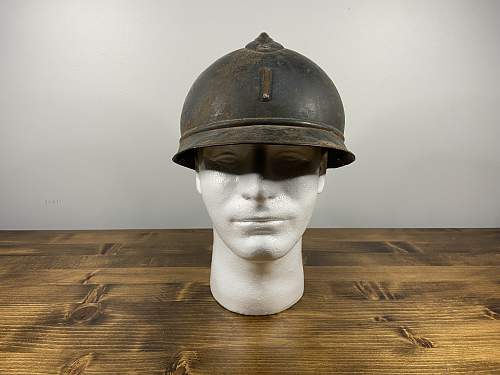
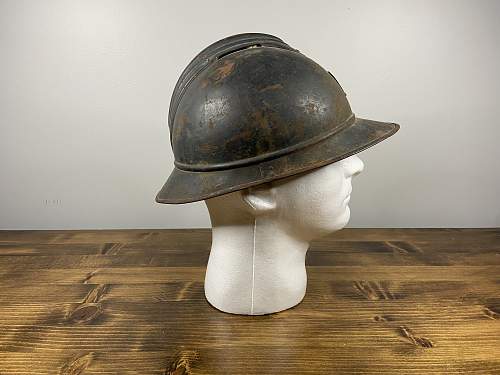




The first helmet to go over is the M15. The first modern combat steel helmet and was introduced during WWI. This is a M15 with no badge on the front and only refinance of the liner. The dark blue is the 2nd layer of paint which is what prominently shows on the helmet today, though in areas where the paint has chipped the original light blue is showing. This light blue paint was later replaced by the darker blue paint which is what mainly covers the helmet today and many early production helmets were over painted in it such as this one. Later though the dark blue paint would become the main base color for these helmets during WWI. The red lining which the progs inside of the helmet pierce in order to hold the liner to the helmet is early war later war the red lining will become blue. This helps to indicate if your helmet is a early or late WWI helmet additionally the light blue paint is also an indicator of a early war helmet.

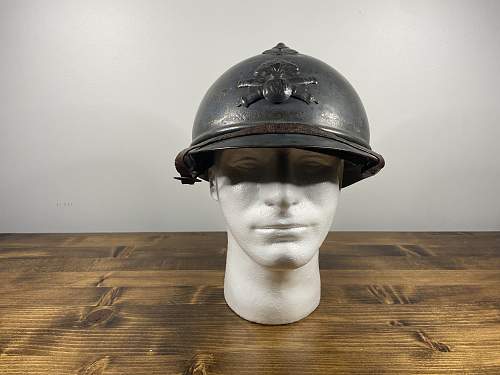



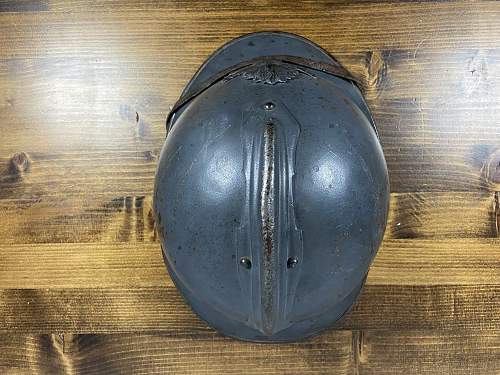

This is an example of a very early production M15 having a type one liner (7 tongues, 1 piece), red liner band, and light horizon blue paint. This one specifically has a badge belonging to the artillery (flaming bomb and crossed cannons, This is also the M15 badge where the badge bulges off of the helmet a lot with here being no circle behind it). This one also has a very rare ink stamp on the brim of the helmet which is quite uncommon as they commonly wore off over time. This helmet can also be seen to have no rivets holding together the two bottom portions of the helmet at the sides (there are 3 different variations for how the two piece front and back brim of the helmet is put together which can be seen throughout these helmets examples being no rivets, lines up rivets, and off set rivets).
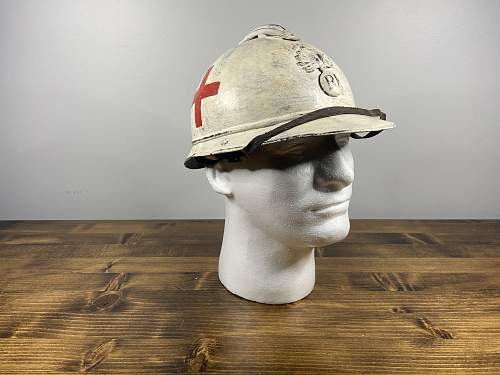



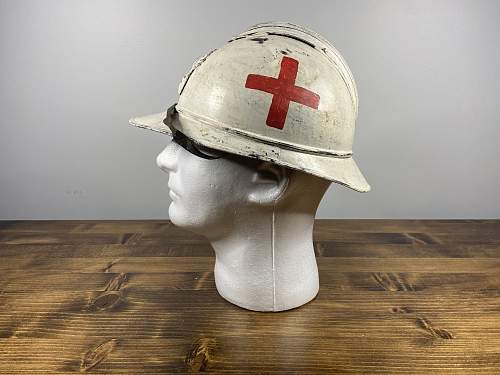


This is an example of a helmet with slight variations from the previous ones having a infantry badge (flaming bomb), base dark blue paint, and off set rivets.


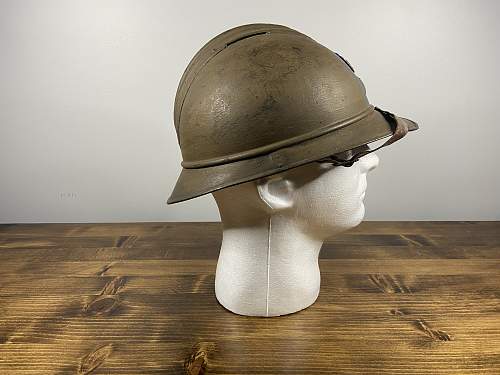




This is an example of a very late WWI helmet having the blue lining and type two liner (6 tongues, separate pieces). This example is in a colonial mustard color. The helmet is domed on the inside of the helmet which is common for French helmets. This is also a rare example of a helmet reused by the French resistance (FFI - French Forces of the Interior).







This is the next main model of French helmets the M26. This helmet though very similar to the M15 has a few major differences. The main thing to notice is the shell is now from a 4 piece to 2 piece construction (counting the crest). The helmet also now has a much more sophisticated liner system using 4 bar supports for the liner. The helmet also now is much better quality compared to the previous 0.7mm metal of the M15 now being 0.9mm improving overall protection. This helmet shows how M26 helmets still sometimes utilized the M15 badge through this would later be improved this one belonging to the Zouaves (Crescent Moon). The M26 also has a different ventilation system which went from a slit in the top of the helmet which the crest protected to being 8 holes (refer back the the 1st helmet to see the ventilation system at the top).

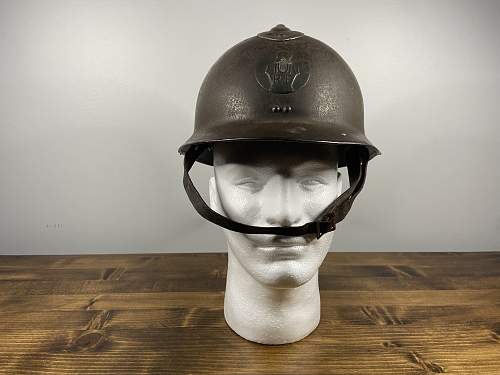





This is an example of a slightly later production M26 this one being produced in 1938 (stamps can be found in the dome) so it was able to get one small improvement. This example has the improved badge the M37 having the same emblem design from the M15 badge's but bulging less and being placed within a circle. The liner is similar to the 2nd model M15 liner but being attached within the helmet differently (clipped to the metal tabs).
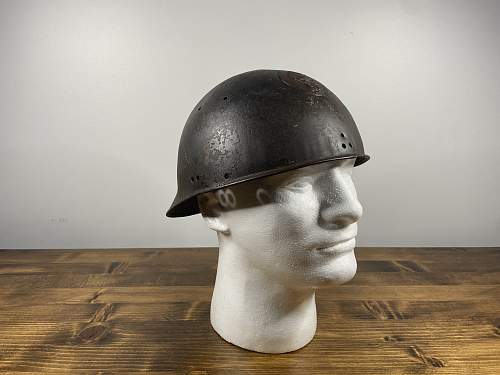






This is an example of what Tankers and Motorized Divisions would wear, the M35. This would have the same liner system as the M26. The helmet at its base is basically a modified M26, The helmet has a similar shell shape though the brim of the helmet is only at the back protecting the neck while at the front there would have been a leather bumper pad (it would be attached through the extra holes located near the liner attachment holes). Rather than having a crest on top with a ventilation system underneath, on the M35 the ventilation holes are simply 4 holes 2 on each side (Left and Right) near the top of the helmet.
I hope this information was somewhat useful to any of you who looked through this.
Thanks for reading,
Adam
Last edited by War Talks; 02-20-2022 at 03:31 PM.
-

Great thread. Thank you!
If I may intrude and show one that must have been made on a Friday!
-

Nicely done. May I also recommend, for the real enthusiast, Roland Hennequin's two volumes CASQUES MILITAIRES FRANCAIS covering 1900 - 1970. Not easy to find now and may be expensive, but excellent. And let us not forget one of my favourite helmets, the mle45 'Jeanne d'Arc' see this thread - The French mle45 Jeanne d'Arc
-

Very nice post and very good sumary.
I love your Artillerie one.
Concerning the liner, the liner band is not always red, it can alos be dark blue or from civilian fur. Basiquely they reused available materials. After they used the Light bleu (Bleu horizon) of reformed uniforms.
Concerning the eveolution of colors, the early production were light (shiny) blue.
Thy where rapidly over painted to avoid theml to shine
after, during production, theyr went twice in the howen so the color wasn't shining any more
Many information would be found on the WWhelmet website World War Helmets - Accueil
Best
Bruno
Similar Threads
-
In Orders, Medals, Badges, Decorations, & Corresponding Documents
-
In WW1 Allies: Great Britain, France, USA, etc 1914 - 1918
-
In Ballistic /composite helmets
-
In German helmets on e-bay just added
-
In Field Equipment And Accessories of the Third Reich
 Posting Permissions
Posting Permissions
- You may not post new threads
- You may not post replies
- You may not post attachments
- You may not edit your posts
-
Forum Rules





















































 .
.

Bookmarks